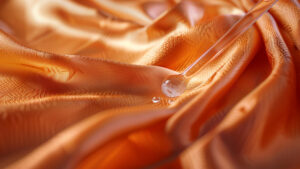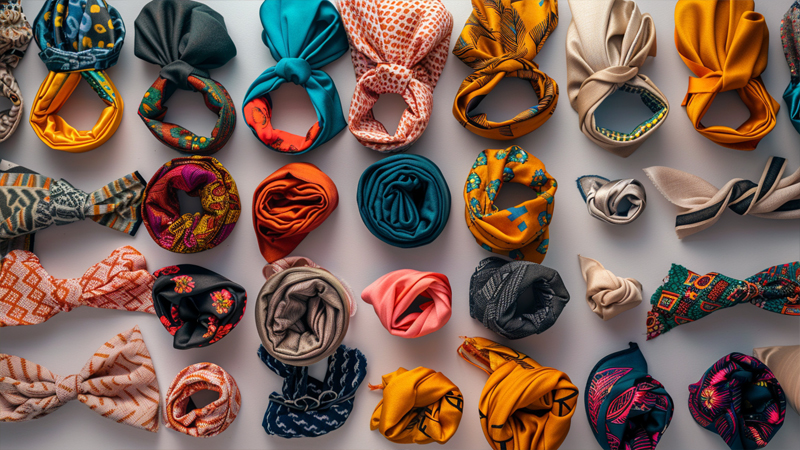
I’ve always believed headscarves and headbands can turn an ordinary hairstyle into something unforgettable.
You can pair or layer them for extra flair, play with seasonal trends, and adapt to different hairdos.
They’re my favorite quick style fix.
How can you coordinate headscarves with headbands?
Combining scarves with headbands can elevate simple looks.
Match colors or prints and secure them together for a stylish yet practical accessory combo.

Whenever I’m in a hurry, I reach for a lightweight headscarf and a matching headband in a similar color palette1. It’s an easy way to look put-together without spending ages in front of the mirror. If my scarf has a floral pattern, I might choose a single-tone headband that matches one of the flower shades. That pop of harmony pulls my outfit together. Plus, layering them helps keep the scarf from slipping. It’s like having a built-in hair safety net.
But you don’t always have to match colors. Sometimes I love mixing prints2—say, a polka-dot headband with a striped scarf—to create a fun, eclectic vibe. If I’m feeling bold, I might even go for contrasting colors, like pairing a bright yellow band with a navy scarf. The key is confidence. As long as you feel good, the combination will shine. And if you’re new to mixing, start small: maybe a subtle design on the headband and a solid-colored scarf, or vice versa. Over time, you’ll develop an eye for what works best with your personal style.
What layering techniques can create a chic look with headscarves and headbands?
Play around with knots, folds, and overlapping details.
Layer a headband over a folded scarf, or weave the scarf around the band for a textured style.
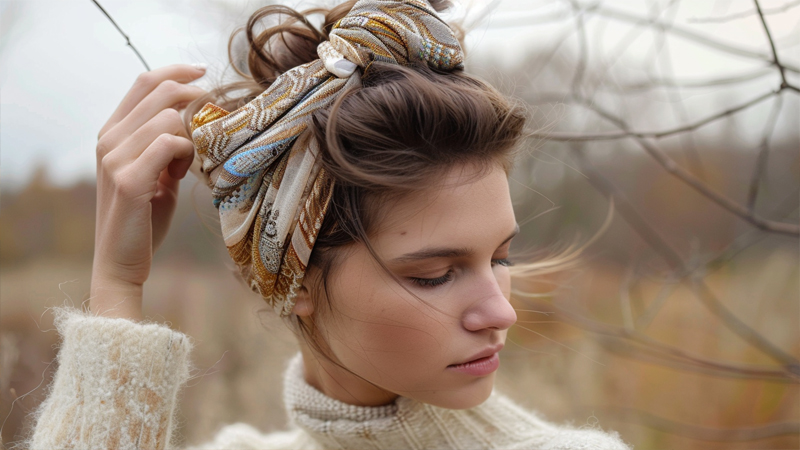
I like to think of layering as “fabric art3.” One method is to fold a large scarf into a narrow band, tie it around my head, and then slide a thin headband right on top. It not only keeps the scarf in place but also adds dimension—almost like wearing two accessories in one. Another approach is to twist a smaller scarf around a plain headband, transforming it into a custom piece. This is great if you want the convenience of a headband but love the color or pattern of a scarf.
Exploring Different Layers
Experimenting is half the fun. If you want a sleek silhouette, choose a lightweight scarf that doesn’t add too much bulk. For a bolder look, pick a scarf with volume—maybe a textured material—and place a headband over it to define the shape. You can also do partial layering, where you tie the scarf at the back and let the headband rest just on your hairline. This style looks especially cool if you leave some bangs or loose strands in front. Even a messy bun can look chic when you wrap a scarf around the base, then add a decorative headband on top.
I’ve found that layering helps on windy days4, too. A headband can anchor the scarf, so it doesn’t blow away in the breeze. If you’re aiming for a more formal vibe, try using a satin or silk scarf beneath a classy, embellished headband. That combination feels rich and luxurious—perfect for weddings or fancy dinners. On casual weekends, I’ll opt for cotton or jersey scarves, layering them with a simple elastic band or sporty headband for a laid-back, comfortable look. Truly, there’s no limit to how creative you can get. The more you practice, the more you’ll discover unique ways to combine these two accessories into a style that’s all your own.
What are the seasonal trends for headscarves and headbands?
Go for light fabrics5 and bright prints in warm months, then switch to cozy textures6 for colder seasons.
Summer favorites include linen or chiffon, while winter calls for wool blends or thicker fabrics with warm colors.
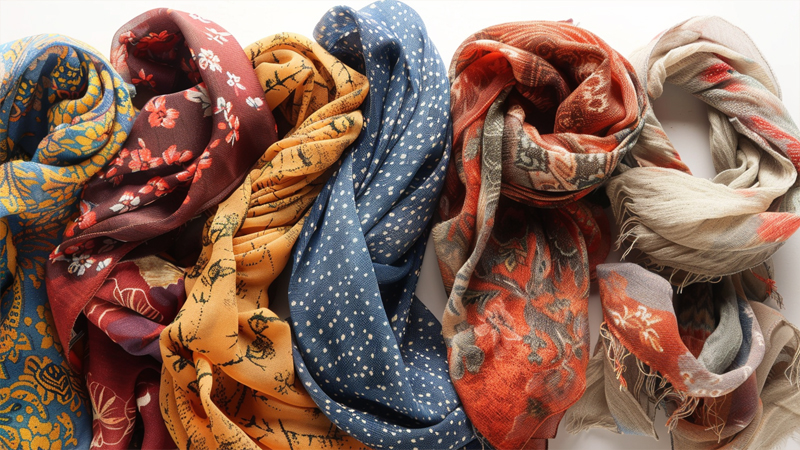
When I step outside in the summertime, the last thing I want is heavy material clinging to my head. That’s why I love airy scarves made from chiffon, cotton, or linen. They feel cool and come in fun prints—like floral designs or tropical patterns. I’ll often pair them with a thin, flexible headband that won’t trap heat. Sometimes, I’ll even choose a bright color scheme to match my flip-flops. It adds a little extra sunshine to my day.
Seasonal Styling Insights
- Spring/Summer: Look for pastel or vivid shades, lightweight fabrics, and breezy designs. Floral motifs and bold prints flourish in these sunny months.
- Autumn: Transition into slightly heavier materials like light wool or jersey. Earthy tones, plaids, or leaf patterns fit the season’s cozy vibe.
- Winter: Embrace thicker, warmer fabrics—like knitted headbands or scarves lined with fleece. Darker hues or jewel tones can add warmth to your outfit. Pair them for extra coverage against chilly winds.
- All-Year Versatility: If you live in a place with unpredictable weather, pick mid-weight fabrics—like a cotton-silk blend. Layer a sweater over your outfit for cooler evenings, or wear the scarf loosely when it’s mild.
Seasonal trends also play with accessories. In autumn, I might tuck a small felt brooch into my headband to bring in that harvest feel. Come winter, sparkly rhinestones or metallic thread in a scarf can be festive for holidays. As spring arrives, pastel bandanas bloom all over social media, and I can’t resist joining in. And in summer, straw hat plus scarf combos pop up for beach days—tying a headscarf around your hat’s base can keep it stylishly in place. With each season, your headscarves and headbands can transform to match the weather and your mood.
What accessorizing tips can enhance different hairstyles with headscarves and headbands?
Try side knots for short hair, sleek wraps for medium length, and layered combos for long hair.
Match your accessory to your hairstyle—whether it’s a pixie cut, shoulder-length, or flowing tresses—to create a balanced look.
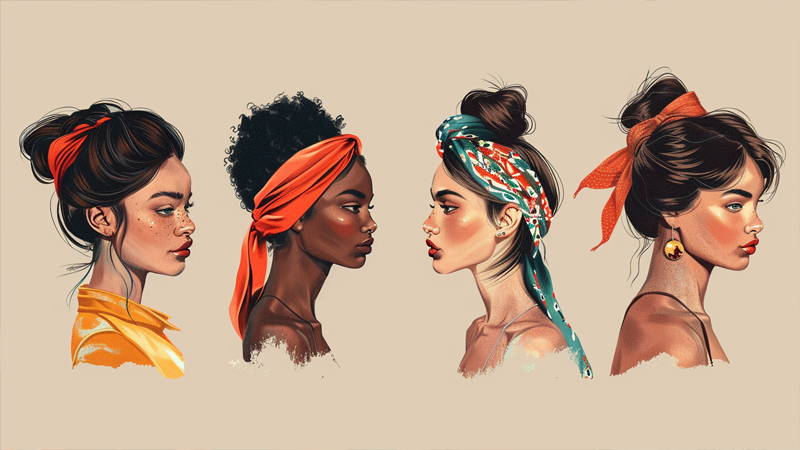
I’ve realized there’s no single “one-size-fits-all” method when it comes to pairing these accessories with different hair lengths and textures. When I had a short bob, a narrow headband or a small scarf tied to the side helped frame my face without overwhelming it. With a pixie cut, a thin, delicate band or a small knotted scarf near the hairline can add charm without too much fuss.
Considering Hair Length and Texture
- Short Hair: If your hair doesn’t allow a big bun or ponytail, focus on decorative headbands with unique patterns7. A tiny scarf bow above your ear can also look playful.
- Medium Hair: Shoulder-length locks open up more styling possibilities. You can loop a scarf around a low ponytail or tuck a headband under the hair for a vintage-inspired vibe. Another trick is wrapping a scarf at the crown, then letting the rest of your hair flow freely.
- Long Hair: Large scarves or wide headbands can highlight the length without getting lost. I like tying a scarf into a braided ponytail8 or layering two scarves for a bohemian flair. Even a messy bun can look intentional with a colorful headband perched just behind your bangs.
Don’t forget about texture. Curly hair can look stunning when the scarf or band accentuates those bouncy coils. A wide, stretchy headband might tame frizz while highlighting the curls in front. For straight hair, a bit of volume created by layering a scarf near the crown can break up an otherwise sleek style. And if you’re rocking waves, tying a scarf in a half-up arrangement can show off both the hair’s shape and the accessory. Ultimately, the goal is to experiment, see what makes you smile, and remember that every hairstyle has its perfect pairing waiting to be discovered.
Conclusion
Headscarves and headbands let me play with color, texture, and style—offering endless ways to feel confident and unique.
-
Learn how to select the perfect headband to complement your scarf, enhancing your outfit's cohesion and style effortlessly. ↩
-
Explore the secrets to successfully mixing prints for a bold, eclectic look that stands out, boosting your fashion confidence. ↩
-
Explore the concept of fabric art to enhance your fashion creativity and learn innovative ways to incorporate it into your style. ↩
-
Discover practical tips on how layering accessories like scarves and headbands can keep your style intact on windy days. ↩
-
Discover the top light fabrics that keep you cool and stylish during the warm summer months. ↩
-
Learn how to select the perfect cozy textures to stay warm and fashionable in the colder seasons. ↩
-
Explore a curated selection of decorative headbands that add a playful and stylish touch to short hairstyles. ↩
-
Learn creative ways to incorporate scarves into braided ponytails, enhancing your long hair with a bohemian flair. ↩


